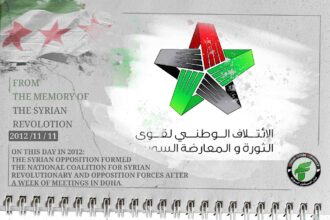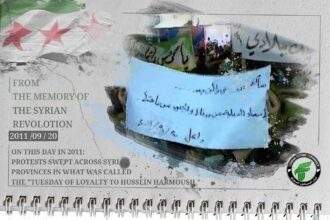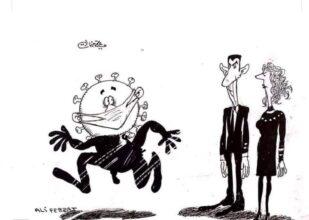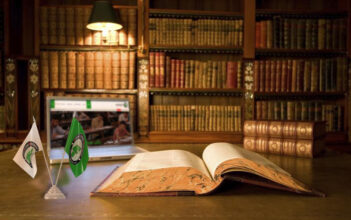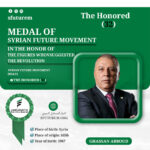Symbols and Figures of the State in Syria (8): Fakhri Albaroudi
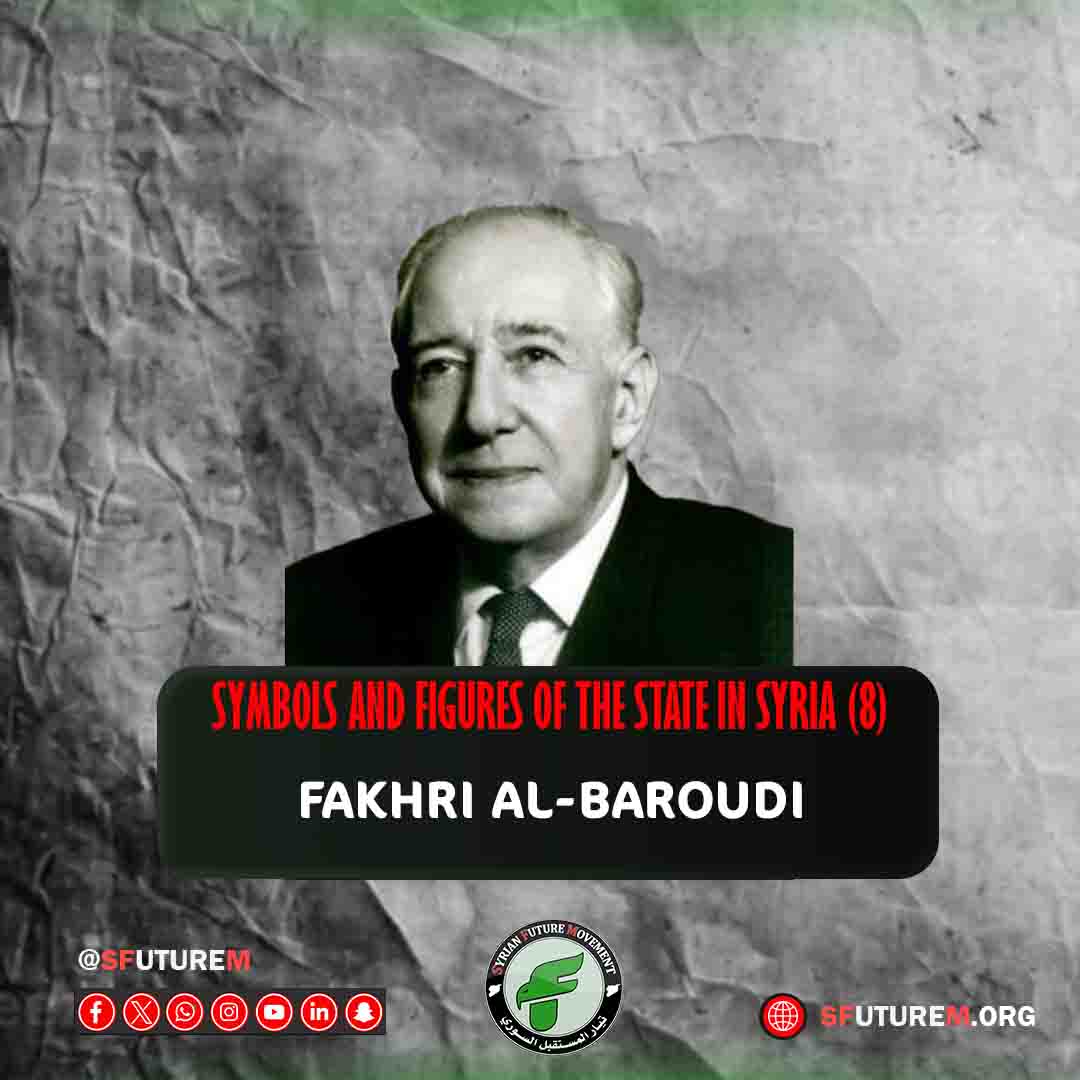
- Fakhri al-Baroudi (March 30, 1887 – May 2, 1966) was born in the Al-Qanawat neighborhood of Damascus. His father, Mahmoud al-Baroudi, was a notable figure, and his mother was from the Palestinian Al-Alami family; her father was an advisor at the court of Sultan Abdulaziz in Istanbul.
- Fakhri al-Baroudi married Safiya al-Dalati, a relative of the First Lady Bahira al-Dalati, wife of President Shukri al-Quwatli. They had no children.
- As the only child of his father, Fakhri was treated with excessive indulgence. His father hired tutors, assistants, and cooks to ensure his comfort.
- Fakhri al-Baroudi studied at the Lazarist School in the Bab Touma area and later at Maktab Anbar. He asked his father to allow him to study agriculture in France, but Mahmoud al-Baroudi refused. In February 1911, Fakhri ran away from home and enrolled at the University of Montpellier in France.
- He was forced to return to Damascus after just one year when his father cut off his financial support and prevented his mother from providing him with any assistance.
- After returning from France, Fakhri worked as an editor for Al-Muqtabas newspaper before founding a satirical weekly called “Hat Bel Khirj,” which he wrote himself in the Damascene dialect, signing all his editorials with the pseudonym “Azrael.”
- When his father found out about it, he forced him to abandon his journalistic project. Fakhri then worked as a clerk at the Damascus Justice Department and later volunteered in the Ottoman army, despite being exempt from compulsory military service as the only son.
- The Ottoman military command assigned him to Beersheba in the Negev Desert, where he fought with the Ottomans in World War I and was captured by the British Army in 1917.
- He was taken as a prisoner to Egypt and remained in British custody until the end of the war and the fall of the Ottoman Empire in Syria in 1918.
- Afterward, Fakhri al-Baroudi returned to Damascus and pledged allegiance to Prince Faisal bin Hussein, the son of Sharif Hussein bin Ali, the leader of the Great Arab Revolt, who had become the ruler of Syria. During his visits to Damascus…
- Before the war, Prince Faisal would often be a guest at Mahmoud al-Baroudi’s home in the Al-Qanawat area, where he became acquainted with Fakhri al-Baroudi and grew fond of him. As a result, Faisal appointed him as his personal aide throughout his rule in Damascus, from October 3, 1918, until the Battle of Maysalun on July 24, 1920.
- Mahmoud al-Baroudi was elected as a representative for Damascus in the First Syrian Congress and, along with his son, participated in the coronation of Prince Faisal as King of Syria on March 8, 1920.
- After Faisal’s rule was toppled by the French army in accordance with the Sykes-Picot Agreement between France and Britain during World War I, King Faisal left for Haifa in Palestine and then to Europe in search of a new throne for himself and his family. Fakhri al-Baroudi was sentenced to death by the French Mandate authorities.
- He fled to the Emirate of Transjordan before an arrest warrant was issued and remained in Amman until 1923.
- Two years later, Fakhri al-Baroudi returned to Syria and joined the People’s Party, the first political party in Syria during the occupation, led by Dr. Abdul Rahman al-Shahbandar, whom al-Baroudi knew well from their joint work in King Faisal’s court when al-Shahbandar was Foreign Minister.
- Al-Baroudi participated in the Great Syrian Revolt alongside its leader, Sultan Pasha al-Atrash, which led to him being sentenced to death again. He fled once more to Amman, where he stayed for nearly two years.
- During his exile in Jordan, al-Baroudi faced financial difficulties as the funds sent by his family in Damascus dwindled. He opened a restaurant for intellectuals in the Jordanian capital, which he named “Al-Nadwa,” serving sandwiches and refreshments. Despite this, financial troubles continued to plague him, prompting him to pursue a new venture. He collaborated with his friend, the Palestinian poet Ibrahim Touqan, the head of the Arabic Language Department at the British Broadcasting Corporation, to produce a series of educational programs for Arab children, encouraging good citizenship and combating colonialism through culture and the pen rather than the gun.
- The French Mandate authorities cut off the electricity in Damascus on the broadcast day to prevent al-Baroudi’s voice from reaching his people, fearing his influence on Syrian youth. They also pressured the BBC to cancel the program.
- In a final moment of despair, al-Baroudi decided to volunteer for the Iraqi army, given his past service as an aide to King Faisal I, who had ascended to the throne in Baghdad after being deposed from the Syrian throne. However, the Iraqi government rejected his proposal because al-Baroudi did not hold Iraqi citizenship.
- After returning to Damascus, Fakhri al-Baroudi joined the National Bloc, the most prominent political organization in Syria that fought the French Mandate through non-military means. He was elected as a representative for his city in the Constituent Assembly, tasked with drafting the first republican constitution for the country.
- He was re-elected as a representative for Damascus in every legislative session from 1928 to 1943, winning by an absolute majority in each session due to his great popularity among youth and intellectuals.
- Al-Baroudi refused to accept any government position throughout his life, despite the various ministerial posts offered to him during the terms of Hashim al-Atassi (1936-1939) and President Shukri al-Quwatli (1943-1949). He preferred to remain a member of the Syrian Parliament, defending the rights of the poor, the needy, the creative, and the free patriots.
- Al-Baroudi took on the task of opposing the rule of Sheikh Taj al-Din al-Hasani, who was affiliated with the Mandate authorities and had been appointed Prime Minister in 1928.
- When Sheikh Taj returned to power in 1934 and attempted to pass a friendship treaty with the French government to legitimize the French Mandate, Fakhri al-Baroudi declared his rejection of the project, stating: “The friendship treaty with France will not pass even if they set up 70 cannons on the walls of Damascus!”
- After the death of the Aleppo leader Ibrahim Hanano in November 1935, Fakhri al-Baroudi participated in his funeral, which turned into a popular demonstration against the French occupation, led by al-Baroudi and his colleagues in the National Bloc.
- France considered al-Baroudi the main instigator against them and ordered his arrest on January 20, 1936, sparking the nationwide “Sixty-Day Strike” which demanded the release of the detainees and recognition of the just demands of the Syrian people.
- Negotiations took place at the French High Commission in Beirut between the head of the Bloc, Hashim al-Atassi, and the High Commissioner Henri de Martel, which led to the end of the strike and the issuance of a pardon for all political detainees, including Fakhri al-Baroudi.
- In 1934, Fakhri al-Baroudi founded the first research and studies center known in the Arab world as the “Al-Baroudi Office for Propaganda and Publishing,” aimed at providing an informational and intellectual base for the Syrian national movement.
- He rented a corner of the National Bloc’s office near his home in the Al-Qanawat area, declaring the launch of a “intellectual revolution” in Syria, based on scientific research and publishing, and dismantling the artificial borders imposed in the Levant (i.e., the Sykes-Picot Agreement), as well as rejecting sectarianism, tribalism, and clan-based politics.
- He bought a private printing press to print the publications and studies issued by his office and distributed them for free to universities, mosques, churches, and Jewish places of worship, as well as to major Arab newspapers and all Syrian state institutions.
- The topics that al-Baroudi wrote about ranged from the crimes of Zionist gangs in Palestine, through the right of self-determination for third-world nations, to the issue of the Sanjak of Alexandretta, the Syrian region that was annexed by Turkey in 1939.
- He contracted with a group of educated young people to manage his office and oversee his research, including Dr. Nazem al-Qudsi, a young lawyer recently returned from the University of Geneva; Dr. Farid Zayn al-Din, a graduate of the American University in Beirut who later became Syria’s ambassador to both Washington and Moscow; attorney Edmond Rabat, who participated in the 1936 negotiations; attorney Ahmad al-Samman, a graduate of the Sorbonne who later became President of the University of Damascus during the union with Egypt; journalist Munir al-Rais, owner of the newspaper “Bardaa”; and Dr. Constantine Zurayk, a prominent theorist of Arab nationalism who became President of both the University of Damascus and the American University of Beirut. Among the Arab youth, he contracted with Akram Zaytar from Palestine, who later became his country’s ambassador to the Arab League, and Kazem al-Solh from Lebanon, founder of the National Call Party. These young people formed the general assembly of al-Baroudi’s office and elected him as their president for a five-year term.
- In addition to scientific research, al-Baroudi employed several young photographers in Palestine to capture photographs of the Jewish gangs’ violations against the Arab population and their confiscation of land and property. Al-Baroudi collected these photos in Damascus and sent them to major American and British newspapers, demanding their publication, accompanied by an official letter stating: “With regards from the Al-Baroudi Office.”
- He established a special room to preserve Syrian maps before and after the demarcation of borders following the collapse of the Ottoman Empire, and another room to store documents of land ownership in Palestine, listed among the Jewish Agency’s ambitions.
- At the beginning of each summer, after the annual graduation of students from the University of Damascus, Fakhri al-Baroudi would hold an official reception at his home, bringing together the new graduates with owners of large factories and companies in Syria. The graduating student would enter wearing a flower on the lapel of his coat, signaling that he was looking for work, and would mingle among factory owners to introduce himself and his specialty. Thus, Fakhri al-Baroudi established the first “employment office” in the Arab world, providing free services to students.
- He organized the work in his office into three committees: the first was economic, concerned with studies of industry, trade, customs tariffs, and transportation; the second was cultural, focusing on arts, theater, encouraging young talents, sports, singing, and music; and the third was political, aiming at governance, constitution, and political and parliamentary life.
- Al-Baroudi also created specialized study rooms according to geographical regions: North Africa, Palestine, Syria and Lebanon, the Hejaz, Iraq, Europe, and the Americas.
- To provide information for young researchers, al-Baroudi established a large library and subscribed to several global and local newspapers: 24 from Lebanon, 17 from Damascus, 9 from Brazil, 8 from Baghdad, 7 from Aleppo, 5 from Cairo, 2 from Latakia and Tripoli, and one each from Antioch, Zahle, Homs, Raqraqa, Jerusalem, Jaffa, Mosul, Amman, Libya, Algeria, Greece, Italy, and Chile.
- As for the funding of al-Baroudi’s office, it was through subscriptions to periodicals and donations from Syrian notables and institutions, in addition to al-Baroudi himself, who supported the office with an amount of 40,000 piastres. The surplus funds were used for gifts, such as a Damascene sword presented to the leader of the Great Syrian Revolution, Sultan Pasha al-Atrash, and a Syrian silk flag presented to Hashim al-Atassi upon his election as president in 1936.
- The al-Baroudi Office also published a book about the Bludan Conference and a booklet titled “The Police Guide” by Fakhri al-Baroudi himself, which contained instructions for security and police officers on how to deal with citizens, with illustrated details covering every aspect of their profession, from polishing shoes to how to position a gun on the waist.
- Finally, the office published a study titled “The Palestinian Catastrophe” by al-Baroudi and a translation of Adolf Hitler’s memoirs from German, titled “Mein Kampf.”
- His name was associated with the franc project that emerged in the 1930s and the “Made in Syria” project. In the first project, al-Baroudi asked every citizen to donate one Syrian franc per month to collect a fixed and respectable amount periodically for a public utility project, such as repairing a bridge, paving a road, or purchasing educational materials for a remote school.
- Al-Baroudi refused to accept donations exceeding one Syrian franc, always saying: “This project starts with the poor and returns to the poor. I want the sustainability of the monthly donation and am not looking for large amounts from individuals. Everyone can donate one Syrian franc, whether rich or poor. I want to involve the poor in the renaissance of the Syrian nation, and I do not want the donations of the rich to overshadow those of the middle class and the needy themselves.”
- He promoted the franc project himself by printing images of him holding a large Syrian franc and distributing them to Syrian newspapers and magazines. However, due to the great success of the “Franc Project,” France prevented its continuation, and it ended by the end of 1939.
- His second project, “Made in Syria,” aimed to encourage and support national industry. Al-Baroudi started it by creating the “Economic Charter” and distributed it to merchants in Damascus, asking everyone to consider it a guide in their commercial work.
- The charter requested merchants not to import items already available in local markets and encouraged people to buy locally produced goods such as vegetables, cheeses, legumes, and clothing.
- He toured the markets of the capital and addressed people himself, saying: “Jihad is not only about bearing arms. Social, cultural, and economic jihad is no less sacred in fighting the enemy.”
- In 1938, he traveled to the United States to register Syrian companies and factories at the New York World’s Fair.
- He, along with lawyer Ahmad Izzat, established the Eastern Music Club, which later became the “Music Institute” after the evacuation. It was located in the ancient Saroujah market, outside the walls of the old city of Damascus.
- He hired teachers from Austria to teach piano and violin, brought in lawyer Najat Kassab Hassan to manage the project, and included several experts such as Yahya al-Saudi, a teacher of Eastern music theory; Yusuf al-Betruni for Western music; Saleh al-Muhbak for Muwashahat (a genre of Arabic music); Hassan al-Darkazli for solfège; Said Farhat for rhythm; and Muhammad al-Nahas for playing the oud.
- He received financial support from the government during President Shukri al-Quwatli’s tenure. However, this item in the general budget was canceled at the end of the summer of 1949, when Michel Aflaq, the founder of the Ba’ath Party, took over as Minister of Education in Syria. Aflaq considered it wasteful and unnecessary expenditure.
- Al-Baroudi wrote to Aflaq expressing his dissatisfaction:
“The departure of a nationalist deputy
They defied my words and did not understand my intent
To establish an institute of art that revives
The heritage of our ancestors among the people
But what excuse can there be, I wonder,
For the men of science, the leaders of rectitude
When they remain as confused as others
And did nothing to reform corruption
Woe to the ministry and its people
Woe to education and the country.” - Al-Baroudi’s connection to the arts dated back to his father, Mahmoud al-Baroudi, who used to gather musicians in his palace, such as the qanun player Omar al-Jarrah and his brother, the oud player Ibrahim al-Jarrah. Al-Baroudi repeated this experience years later by adopting the comedian Abdel Latif Fathy in the 1940s, encouraging him to replace the Egyptian or classical dialects prevalent in theater at the time with the spoken Damascene dialect. He supported a group of young artists, including Riyad Shahroor, Saad al-Din Bakkadous, and Nihad Qalai, who was so influenced by al-Baroudi that he adopted his “soprano” voice for the character of “Hossni al-Borzan” in black-and-white works with Dureid Lahham on Syrian television.
- Additionally, al-Baroudi supported the talented monologist Salama al-Aghawani, the artist Fahd Kaikati, and the singer of Qudud and Muwashahat, Sabah Abu Qaws. Al-Baroudi sponsored Abu Qaws when he recognized his talent, bringing in top Eastern music instructors to teach him the art of singing, and introduced him to Radio Damascus as a professional singer. He also invited him to perform in front of President Shukri al-Quwatli, giving him the stage name “Sabah Fakhri,” which has been used ever since.
- Between 1943 and 1963, al-Baroudi’s home in al-Qanawat became a haven for all Arab artists and intellectuals. Umm Kulthum would visit whenever she came to Damascus, and Mohammad Abdel Wahab and Ahmed Shawqi would also visit. In his expansive grounds, discussions on politics and intellectual matters of all kinds took place. These Baroudi soirées became a key gathering point for every Arab intellectual visiting Syria from the 1930s until the mid-1960s.
- Al-Baroudi was forced to sell the house he inherited from his father due to mounting debts, and the home was converted into a printing press for Syrian journalist Wajih Baydoun. Al-Baroudi moved to a modest house in the Kiwaneh area, which was completely destroyed by fire in 1963.
- He, along with lawyer Munir al-Ajlani, founded what was known at the time as the National Youth, the quasi-military arm of the National Bloc, which al-Baroudi intended to be the nucleus of the Syrian army in the future.
- The idea evolved in 1936 into the “Iron Shirts,” inspired by the brown shirts in Italy and the black shirts in Nazi Germany.
- In the Syrian version of these organizations, the youths wore a black tie, an iron-colored shirt, military boots, and a Faisal-style hat similar to those worn by King Faisal I and his officers during the Great Arab Revolt. The “shirts” wore a red band on their right arms resembling Hitler’s band, but instead of the swastika, the Syrians placed an image of a hand holding a torch of light.
- With their orderly military marches and Nazi-style salute, extending the right hand forward in a stiff and upright manner, they patrolled the streets of Damascus to protect the citizens from harm and maintain the city’s security, heritage, and cultural identity, considering themselves a complement to the disbanded Syrian army since 1920.
- The founders of the “Iron Shirts” promised to establish a “three-dimensional generation” akin to the Renaissance men of Europe, mastering poetry, politics, literature, mathematics, modern sciences, as well as chivalry and street combat.
- Due to the many similarities between the Iron Shirts and the Nazi Party, it was said that the organization was one of Hitler’s arms in Syria, leading the French authorities to dissolve it and confiscate all its offices and property.
- When the French army bombarded the Syrian capital, Damascus, on May 29, 1945, targeting the Syrian parliament with bombs in an attempt to assassinate the Speaker of the Parliament, Saadallah al-Jabri, and President Shukri al-Quwatli, al-Baroudi took to the streets wearing Iron Shirts attire. He carried a weapon with gendarmerie and volunteers in an attempt to rescue prisoners from the Citadel of Damascus. He was injured by shrapnel in his neck and helped transport the wounded to the British hospital in the al-Qassaa neighborhood, bringing wax from churches for their treatment after France had cut off electricity to Damascus.
- The Syrian government honored him with the Order of Merit, first class, and an honorary rank in the newly established Syrian army after independence.
- Al-Baroudi did not differentiate between one ruler and another despite his long-standing friendship and camaraderie with the men of the National Bloc. He considered himself working for the Syrian state, not for individuals, and remained active in the public scene even after the military took power with the coup led by General Husni al-Zaim in 1949, which ousted President Shukri al-Quwatli, al-Baroudi’s old friend.
- Husni al-Zaim appointed him as the director of the propaganda office in the Syrian army, where al-Baroudi contracted young filmmaker Ismail Anzour to produce documentaries about the army and its combat capabilities. These films were shown on his orders in Syrian cinemas during the Palestinian War.
- In 1956, he worked on the “Armament Week” committee to raise funds for the military, alongside journalist Nassouh Babileh and the Syrian Mufti, Dr. Abu al-Yasar Abidin. They collected 25 million Syrian pounds from the public, which was donated to the Syrian army.
- One of the criticisms from religious figures against al-Baroudi was his book from his youth titled “The Decisive Word between Veil and Unveiling,” in which he defended the unveiling of women.
- In 1951, al-Baroudi had a confrontation with the prominent Damascus judge, Sheikh Ali al-Tantawi, over the “Sama’ dance,” which al-Baroudi intended to revive. This dance had previously been reserved for sheikhs and mystics. Al-Baroudi decided to adopt and teach this Andalusian dance to the students of the Doha al-Adab School, which educated the elite girls of Damascus. He believed that the dance would vanish if it remained confined to the realm of sheikhs, so he sought to modernize it in collaboration with Adila Behem, the president of the Women’s Union and founder of the Doha al-Adab School.
- He brought Sheikh Omar al-Batsh from Aleppo, a master of Muwashahat and a leading authority on traditional singing, to train the girls in singing. He had them fitted with brightly colored silk garments to perform on the stage of the Azem Palace, presenting a dance performance in the presence of Prime Minister Khalid al-Azm and Colonel Adib al-Shishakli, the military ruler of Syria.
- Al-Baroudi revised the lyrics of the Muwashahat, replacing the themes of supplication and prayer with expressions of love and passion.
- Despite the disagreement, Sheikh Ali al-Tantawi acknowledged in his memoirs al-Baroudi’s social and political stature, recognizing him as one of the prominent figures in the struggle against colonialism.
- Following al-Tantawi’s broadcasted sermon, a fierce campaign was launched against him in most of the newspapers supportive of al-Baroudi. The campaign was led by the newspaper “Al-Nidal,” affiliated with Interior Minister Sami Kabara, which called for al-Tantawi to be referred to the judiciary. The debate then moved into the legislative council, where one of al-Tantawi’s main defenders was Minister Muhammad Mubarak, a representative of the Muslim Brotherhood.
- The outcome of the parliamentary session was in favor of al-Baroudi, with al-Tantawi being found guilty of incitement against the state and sentenced to a monetary fine equivalent to a deduction of one-tenth of his salary for two months.
- After the union with Egypt and the issuance of the land reform law in September 1958, seven months after the formation of the United Arab Republic, al-Baroudi dared to write an open letter to Gamal Abdel Nasser opposing the law. As a result, Vice President Akram al-Hourani sent him a warning via the Damascus governorate, demanding that he vacate his home in the Kiwān area on the pretext that the municipality planned to open a road there.
- The secession coup occurred before Akram al-Hourani could execute his plan, and al-Baroudi remained in his home until the summer of 1963, when he was forced to leave after his house was burned during the bloody confrontations between the Ba’athists and Nasserists at the entrance to the television building in the Omayyad Square.
- Al-Baroudi was unharmed that day because he was out of the house, but his precious library was lost, along with most of his handwritten papers and memoirs.
- He then rented a small apartment in the Rukn al-Din neighborhood on the slopes of Mount Qasioun, where he lived until his death on May 2, 1968.
- Al-Baroudi left behind several works, including: “The Decisive Word between Veil and Unveiling” (Damascus, 1934), “The Policeman’s Guide” (Damascus, 1938), “The Catastrophe of Palestine” (Damascus, 1950), “Al-Baroudi’s Memoirs: Sixty Years of Speaking” (Beirut, 1951), “Peace with Israel” (Damascus, 1957), “History Speaks” (Damascus, 1960), and his last work, a reprint of a cookbook by Muhammad Hassan ibn Muhammad al-Baghdadi, which he supplemented with a small book on Levantine cuisine, published in 1964.
- He also compiled a dictionary on Eastern music, which was destroyed in the fire at his home in 1963.
- He received his first medal during World War I, when the Ottoman Empire awarded him the Ottoman Iron Medal. This was followed by the Independence Medal and the Arab Renaissance Medal, both awarded by King Faisal I in 1920. In 1948, he received the Syrian Order of Merit, First Class, presented by President Shukri al-Quwatli. This was followed by the Lebanese Order of Merit, awarded by President Bashar al-Khuri in 1949.
- His funeral was both a public and official event, with the people of Damascus gathering in front of the Badr Mosque in the Abu Rumaneh neighborhood, waiting for the procession to arrive from his brother’s house in the Muhajirin area. It was said that no one from Damascus missed his farewell.
- He was known by many titles, including: “Master of the Gentlemen” and “Sheikh of the Youth of Syria.”
- The procession appeared from afar, with the coffin wrapped in the Syrian flag and carried on the shoulders of men who chanted: “There is no god but Allah… Fakhri Bey is the beloved of Allah.”
- After the prayer, the procession, accompanied by police and gendarmes, proceeded to the Justice Palace. A group of youths then took the coffin and carried it to the Souk al-Bzourieh, then to Souk Medhat Pasha, and finally to Souk al-Hamidiyya, in a popular display that closed all the markets and shops until the body reached the Umayyad Mosque.
- He was buried in the Bab al-Saghir Cemetery.
At the Syrian Future Movement (SFM), as we commemorate the founding fathers of Syria, we recall one of Syria’s influential figures and a symbol of the first Syrian state who contributed to shaping its structure: “Fakhri al-Barudi,” the Master of Gentlemen and Sheikh of the Youth of Syria. We present this sequential file to include the symbols and prominent figures of the Syrian state, with the aim of connecting our contemporary revolutionary present to a strong past and historical milestones. We hope to revive in our people the need to build and create exceptional statesmen, to learn from their experiences and benefit from their shortcomings, and to build upon their strengths. By doing so, we aim to safeguard the nation, preserve its achievements, and restore the Syrian state’s honor and glory after years of oppression, tyranny, and corruption.
